Research on the Effect of Calcium Alginate-Red Mud Microspheres on the Performance of Cement Mortar by Partially Replacing Standard Sand
Abstract
1. Introduction
2. Materials and Methods
2.1. Raw Materials
2.2. Preparation and Modification of Calcium Alginate–Red Mud Microspheres
- (1)
- In total, 10 g of sodium alginate powder was dissolved in 500 mL of deionized water under ultrasonic agitation for 4 h to obtain a bubble-free solution. Then, 50 g of red mud was added and stirred thoroughly, followed by 2 h of ultrasonication to yield a sodium alginate–red mud suspension.
- (2)
- The suspension was dripped into a saturated calcium chloride solution using a syringe, forming hydrogel microspheres, which were filtered and rinsed with water to remove residual CaCl2 and then dried in an oven at 65 °C to a constant weight.
- (3)
- In total, 20 mL of KH-550 silane coupling agent was dispersed in 100 mL of ethanol, into which 2 g of nano-silica and 10 g of the dried microspheres were added, followed by 2 h of ultrasonication.
- (4)
- The modified microspheres were filtered, washed with deionized water to remove unreacted KH-550 and silica, and oven-dried at 65 °C to a constant mass.
2.3. Preparation of Modified Cement Mortar
2.4. Testing and Characterization Methods
2.4.1. Mechanical Properties
2.4.2. Microscopical Properties of Modified Cement Mortar
3. Results
3.1. Modified Cement Mortar Characterization
3.1.1. Fluidity Test of Modified Cement Mortar
3.1.2. Mechanical Properties of Modified Cement Mortar
3.2. FTIR Analysis of Cement Mortar
3.3. XRD Analysis of Cement Mortar
3.4. SEM Analysis of Cement Mortar
3.5. TG Analysis of Cement Mortar
3.6. Toxicity Leaching Analysis
3.7. BET Analysis of Cement Mortar
4. Discussion
5. Conclusions
- (1)
- Mechanical tests demonstrated that the inclusion of red mud microspheres significantly improved the compressive strength of cement mortar at both 7 and 28 days. The optimum mechanical performance was achieved at a 2.5% replacement level. Furthermore, CMC-RM-SiO2 mortars outperformed those incorporating unmodified red mud microspheres.
- (2)
- XRD and TG analyses revealed that the nano-silica-modified microsphere surfaces provided additional nucleation sites for cement hydration, resulting in the increased formation of C–S–H gel and enhanced hydration kinetics.
- (3)
- BET analysis showed that the addition of microspheres reduced the total pore volume of the mortar, leading to a denser microstructure that contributed to improved mechanical properties and enhanced structural stability.
- (4)
- The mechanical performance results of modified cement mortars indicated that at replacement rates ≤10%, the contribution of red mud microspheres to compressive strength was comparable to that of quartz sand, with only a 3.1% reduction observed for CMC-RM-10% compared to the reference.
Author Contributions
Funding
Institutional Review Board Statement
Informed Consent Statement
Data Availability Statement
Conflicts of Interest
References
- Ayyam, V.; Palanivel, S.; Chandrakasan, S. Sand mining and strategies for its management. In Coastal Ecosystems of the Tropics—Adaptive Management; Springer: Singapore, 2019; pp. 201–217. [Google Scholar]
- Binici, H. Effect of crushed ceramic and basaltic pumice as fine aggregates on concrete mortars properties. Constr. Build. Mater. 2007, 21, 1191–1197. [Google Scholar] [CrossRef]
- Dos Anjos, M.A.G.; Sales, A.T.C.; Andrade, N. Blasted copper slag as fine aggregate in portland cement concrete. J. Environ. Manag. 2017, 196, 607–613. [Google Scholar] [CrossRef] [PubMed]
- Aggarwal, Y.; Siddique, R. Microstructure and properties of concrete using bottom ash and waste foundry sand as partial replacement of fine aggregates. Constr. Build. Mater. 2014, 54, 210–223. [Google Scholar] [CrossRef]
- Arulmoly, B.; Konthesingha, C.; Nanayakkara, A. Performance evaluation of cement mortar produced with manufactured sand and offshore sand as alternatives for river sand. Constr. Build. Mater. 2021, 297, 123784. [Google Scholar] [CrossRef]
- Ledesma, E.F.; Jiménez, J.R.; Fernández, J.M.; Galvín, A.P.; Agrela, F.; Barbudo, A. Properties of masonry mortars manufactured with fine recycled concrete aggregates. Constr. Build. Mater. 2014, 71, 289–298. [Google Scholar] [CrossRef]
- Akhtar, A.; Sarmah, A.K. Construction and demolition waste generation and properties of recycled aggregate concrete: A global perspective. J. Clean. Prod. 2018, 186, 262–281. [Google Scholar] [CrossRef]
- Hossain, M.U.; Poon, C.S.; Lo, I.M.; Cheng, J.C. Comparative environmental evaluation of aggregate production from recycled waste materials and virgin sources by lca. Resour. Conserv. Recycl. 2016, 109, 67–77. [Google Scholar] [CrossRef]
- Verian, K.P.; Whiting, N.M.; Olek, J.; Jain, J.; Snyder, M.B. Using recycled concrete as aggregate in concrete pavements to reduce materials cost. JTRP Tech. Rep. 2013. [Google Scholar] [CrossRef]
- Beltrán, M.G.; Barbudo, A.; Agrela, F.; Galvín, A.P.; Jiménez, J.R. Effect of cement addition on the properties of recycled concretes to reach control concretes strengths. J. Clean. Prod. 2014, 79, 124–133. [Google Scholar] [CrossRef]
- Etxeberria, M.; Vázquez, E.; Marí, A.; Barra, M. Influence of amount of recycled coarse aggregates and production process on properties of recycled aggregate concrete. Cem. Concr. Res. 2007, 37, 735–742. [Google Scholar] [CrossRef]
- Brand, A.S.; Roesler, J.R.; Salas, A. Initial moisture and mixing effects on higher quality recycled coarse aggregate concrete. Constr. Build. Mater. 2015, 79, 83–89. [Google Scholar] [CrossRef]
- Dapena, E.; Alaejos, P.; Lobet, A.; Pérez, D. Effect of recycled sand content on characteristics of mortars and concretes. J. Mater. Civ. Eng. 2011, 23, 414–422. [Google Scholar] [CrossRef]
- Evangelista, L.; Guedes, M.; De Brito, J.; Ferro, A.C.; Pereira, M.F. Physical, chemical and mineralogical properties of fine recycled aggregates made from concrete waste. Constr. Build. Mater. 2015, 86, 178–188. [Google Scholar] [CrossRef]
- Khatib, J.M. Properties of concrete incorporating fine recycled aggregate. Cem. Concr. Res. 2005, 35, 763–769. [Google Scholar] [CrossRef]
- Soliman, N.A.; Tagnit-Hamou, A. Using glass sand as an alternative for quartz sand in uhpc. Constr. Build. Mater. 2017, 145, 243–252. [Google Scholar] [CrossRef]
- Mi, H.; Yi, L.; Wu, Q.; Xia, J.; Zhang, B. Preparation of high-strength ceramsite from red mud, fly ash, and bentonite. Ceram. Int. 2021, 47, 18218–18229. [Google Scholar] [CrossRef]
- Zhao, Q.; Shi, Y.; Xue, C.; Jia, Y.; Guo, W.; Wang, D.; Wang, S.; Gao, Y. Investigation of various curing methods on the properties of red mud-calcium carbide slag-based artificial lightweight aggregate ceramsite fabricated through alkali-activated cold-bonded pelletization technology. Constr. Build. Mater. 2023, 401, 132956. [Google Scholar] [CrossRef]
- Liu, S.; Yang, C.; Liu, W.; Yi, L.; Qin, W. A novel approach to preparing ultra-lightweight ceramsite with a large amount of fly ash. Front. Environ. Sci. Eng. 2020, 14, 62. [Google Scholar] [CrossRef]
- Giro-Paloma, J.; Mañosa, J.; Maldonado-Alameda, A.; Quina, M.J.; Chimenos, J.M. Rapid sintering of weathered municipal solid waste incinerator bottom ash and rice husk for lightweight aggregate manufacturing and product properties. J. Clean. Prod. 2019, 232, 713–721. [Google Scholar] [CrossRef]
- Yang, J.; Wang, Z.; Luo, H.; Wang, H.; Chen, L.; Liu, M.; Tang, M.; He, B.J. Preparation and properties of alkali-activated red mud-based artificial lightweight aggregates. Constr. Build. Mater. 2024, 449, 138304. [Google Scholar] [CrossRef]
- GB/T 17671-1999; Method of Testing Cements: Determination of Strength (ISO Method). State Bureau of Quality and Technical Supervision: Beijing, China, 1999.
- JTG 3420-2020; Test Methods of Cement and Concrete for Highway Engineering. Ministry of Transport: Beijing, China, 2020.
- GB/T 2419-2005; Test Method for Fluidity of Cement Mortar. General Administration of Quality Supervision, Inspection and Quarantine of the People’s Republic of China, Standardization Administration of China: Beijing, China, 2005.
- Deng, Q.; Zhuang, Y.; Yang, W.; Zhao, K.; Zhang, S.; Duan, Z.; Xiao, J. Rheological properties of mortar with recycled fine aggregate: From the perspective of particle packing. Constr. Build. Mater. 2025, 465, 140237. [Google Scholar] [CrossRef]
- Wang, Z.; Shui, Z.; Sun, T.; Li, H.; Chi, H.; Ouyang, G.; Li, Z.; Tang, P. Effect of MgO and superfine slag modification on the carbonation resistance of phosphogypsum-based cementitious materials: Based on hydration enhancement and phase evolution regulation. Constr. Build. Mater. 2024, 415, 134914. [Google Scholar] [CrossRef]
- Voicu, G.; Tiuca, G.A.; Badanoiu, A.I.; Holban, A.M. Nano and mesoscopic SiO2 and ZnO powders to modulate hydration, hardening and antibacterial properties of portland cements. J. Build. Eng. 2022, 57, 104862. [Google Scholar] [CrossRef]
- Li, S.; Zhang, J.; Li, Z.; Gao, Y.; Liu, C. Feasibility study of red mud-blast furnace slag based geopolymeric grouting material: Effect of superplasticizers. Constr. Build. Mater. 2021, 267, 120910. [Google Scholar] [CrossRef]
- Chen, Y.; Liu, Y.; Muhammad, Y.; Liu, B.; Wu, H.; Zhao, Z.; Li, J. Resourceful reuse and performance evaluation of modified electrolytic aluminum spent cathode carbon block material as cement admixture. Constr. Build. Mater. 2023, 397, 132453. [Google Scholar] [CrossRef]
- De Matos, P.R.; Neto, J.S.A.; Jansen, D.; De la Torre, A.G.; Kirchheim, A.P.; Campos, C.E. In-situ laboratory X-ray diffraction applied to assess cement hydration. Cem. Concr. Res. 2022, 162, 106988. [Google Scholar] [CrossRef]
- Mantellato, S.; Palacios, M.; Flatt, R.J. Impact of sample preparation on the specific surface area of synthetic ettringite. Cem. Concr. Res. 2016, 86, 20–28. [Google Scholar] [CrossRef]
- Lu, X.; Ye, Z.; Zhang, L.; Hou, P.; Cheng, X. The influence of ethanol-diisopropanolamine on the hydration and mechanical properties of portland cement. Constr. Build. Mater. 2017, 135, 484–489. [Google Scholar] [CrossRef]
- GB 5085.7-2019; Identification Standards for Hazardous Waste. Ministry of Ecology and Environment, State Administration for Market Regulation: Beijing, China, 2019.
- HJ 298-2019; Technical Specifications on Identification for Hazardous Waste. Ministry of Ecology and Environment: Beijing, China, 2019.
- GB 8978-1996; Integrated Wastewater Discharge Standard. State Bureau of Technical Supervision: Beijing, China, 1996.
- Zhou, X.; Huang, W.; Shi, J.; Zhao, Z.; Xia, Q.; Li, Y.; Wang, H.; Li, Z. A novel mof/graphene oxide composite gro@mil-101 with high adsorption capacity for acetone. J. Mater. Chem. A 2014, 2, 4722–4730. [Google Scholar] [CrossRef]
- Tian, K.; Wang, Y.; Hong, S.; Zhang, J.; Hou, D.; Dong, B.; Xing, F. Alkali-activated artificial aggregates fabricated by red mud and fly ash: Performance and microstructure. Constr. Build. Mater. 2021, 281, 122552. [Google Scholar] [CrossRef]
- Sun, Y.; Li, J.S.; Chen, Z.; Xue, Q.; Sun, Q.; Zhou, Y.; Chen, X.; Liu, L.; Poon, C.S. Production of lightweight aggregate ceramsite from red mud and municipal solid waste incineration bottom ash: Mechanism and optimization. Constr. Build. Mater. 2021, 287, 122993. [Google Scholar] [CrossRef]
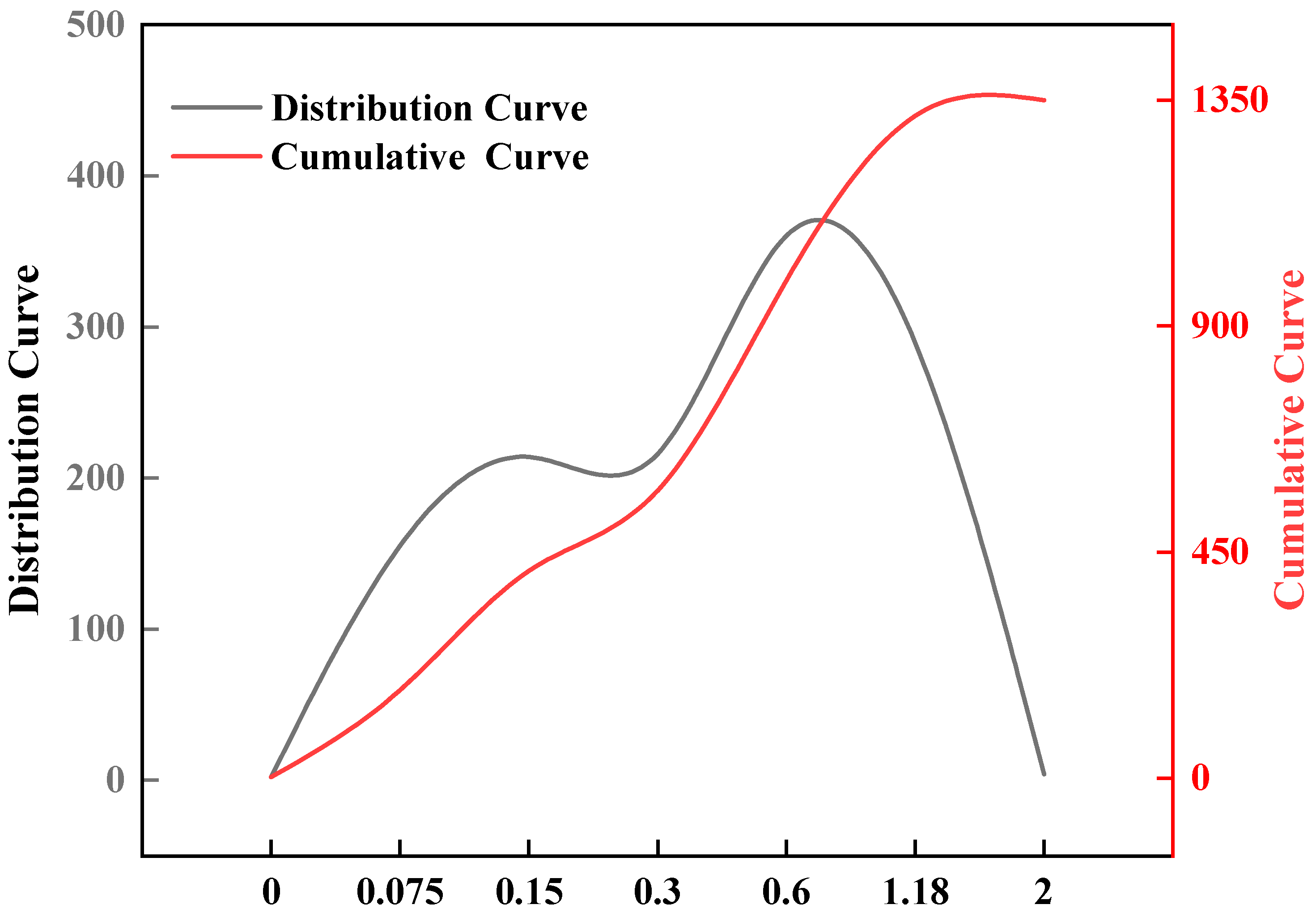
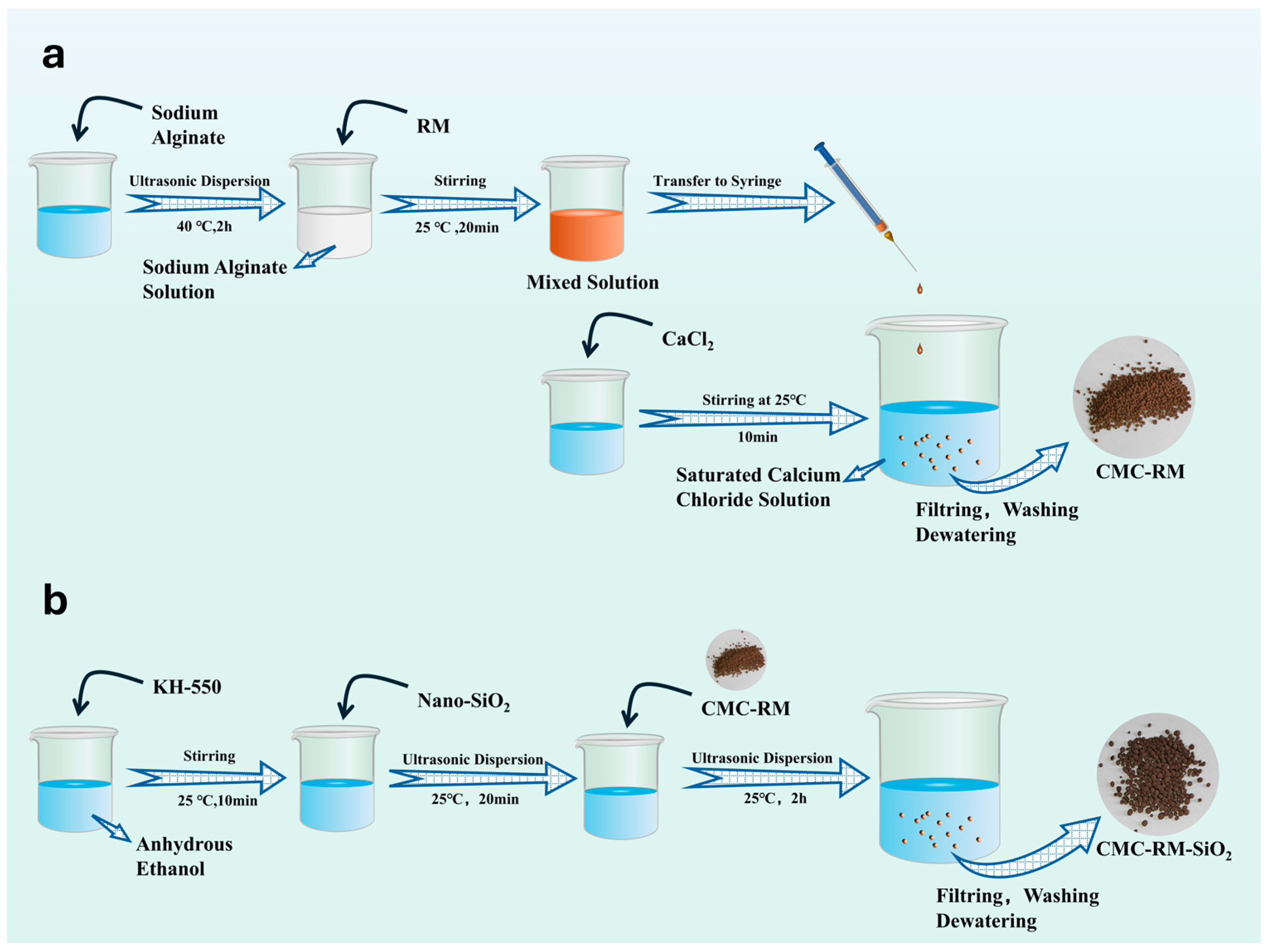
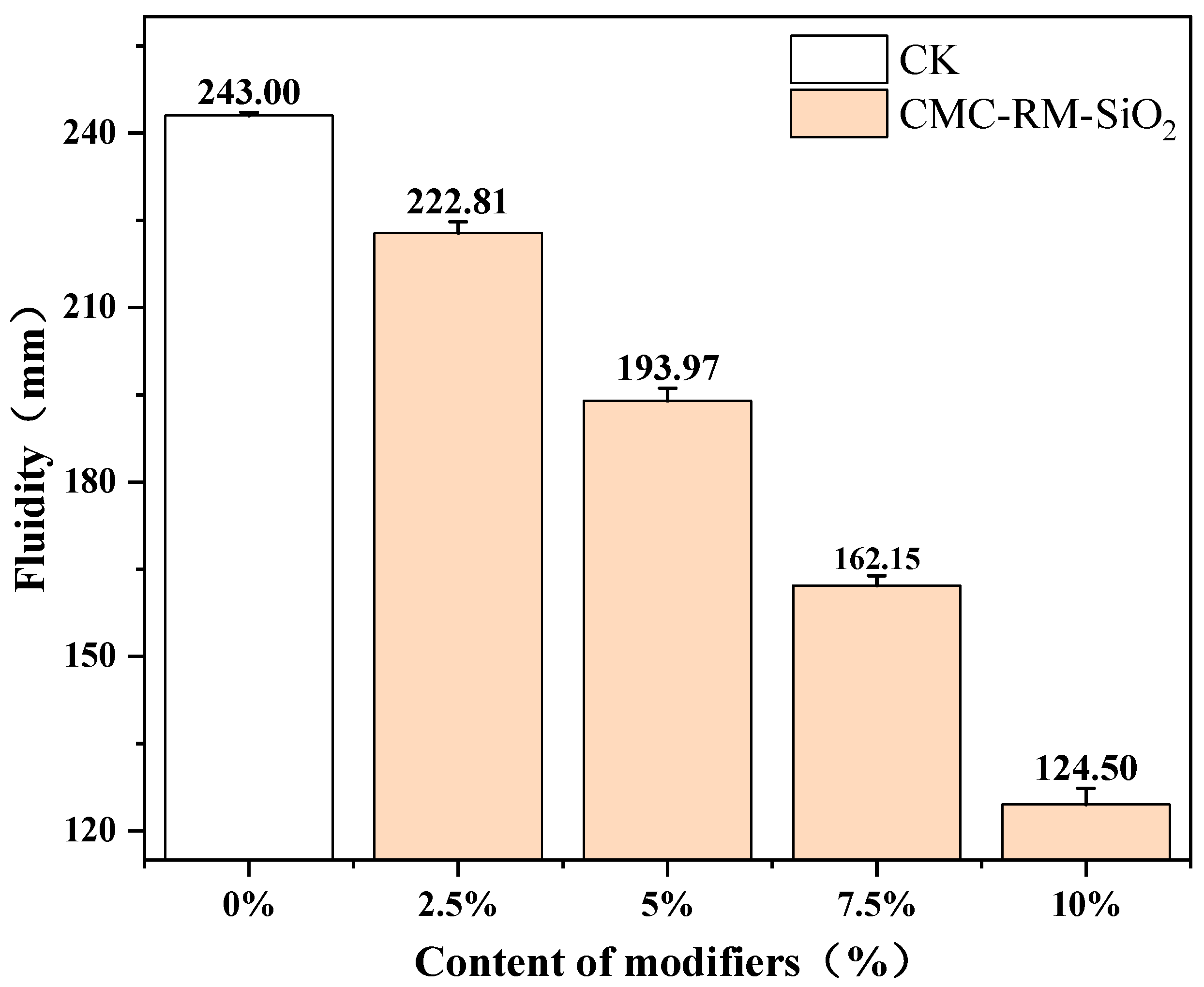
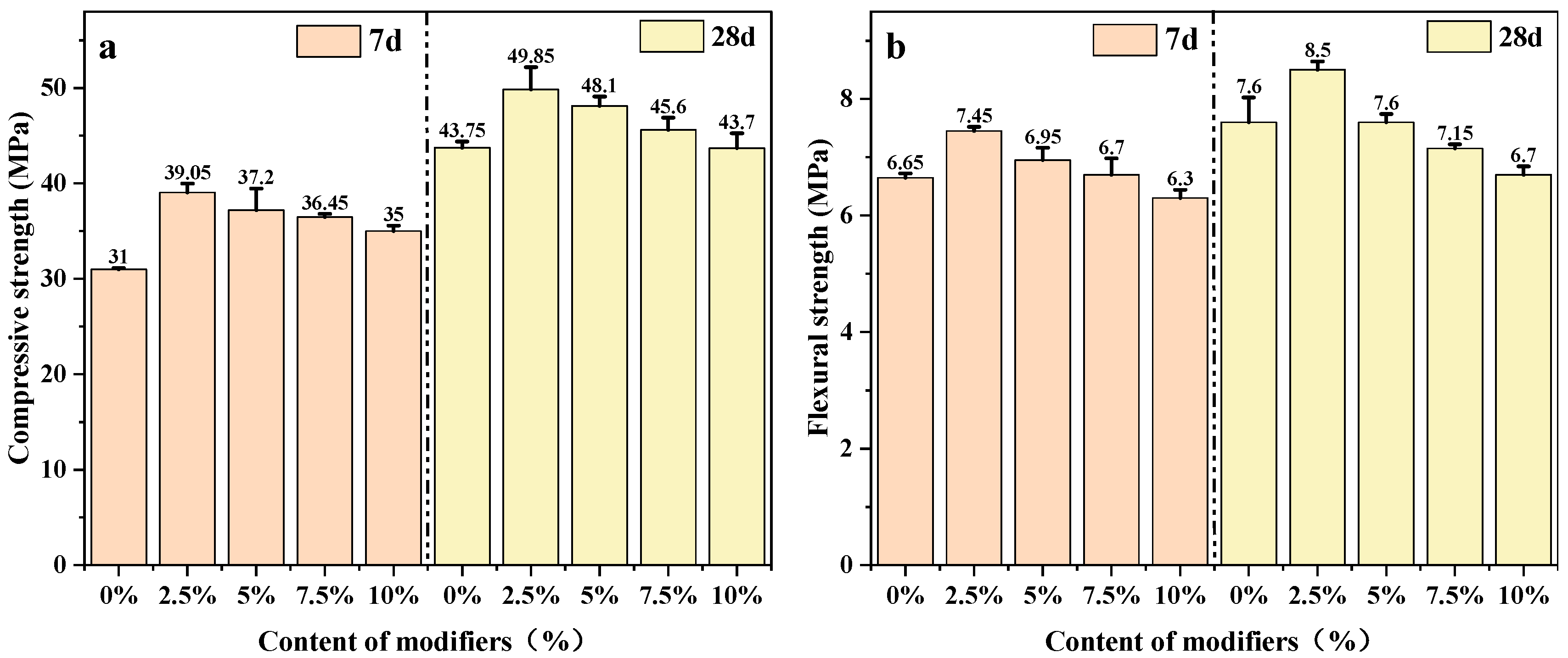
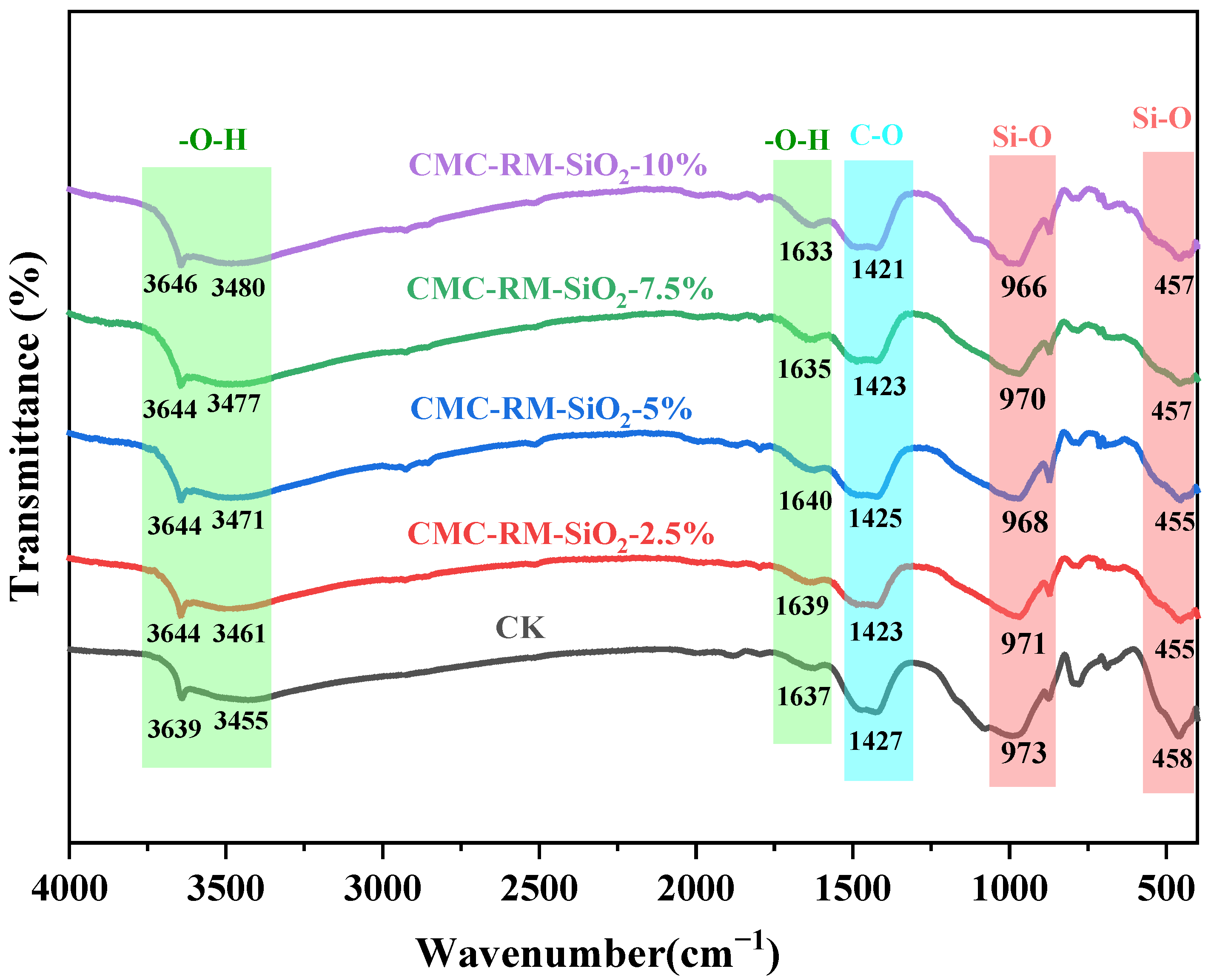

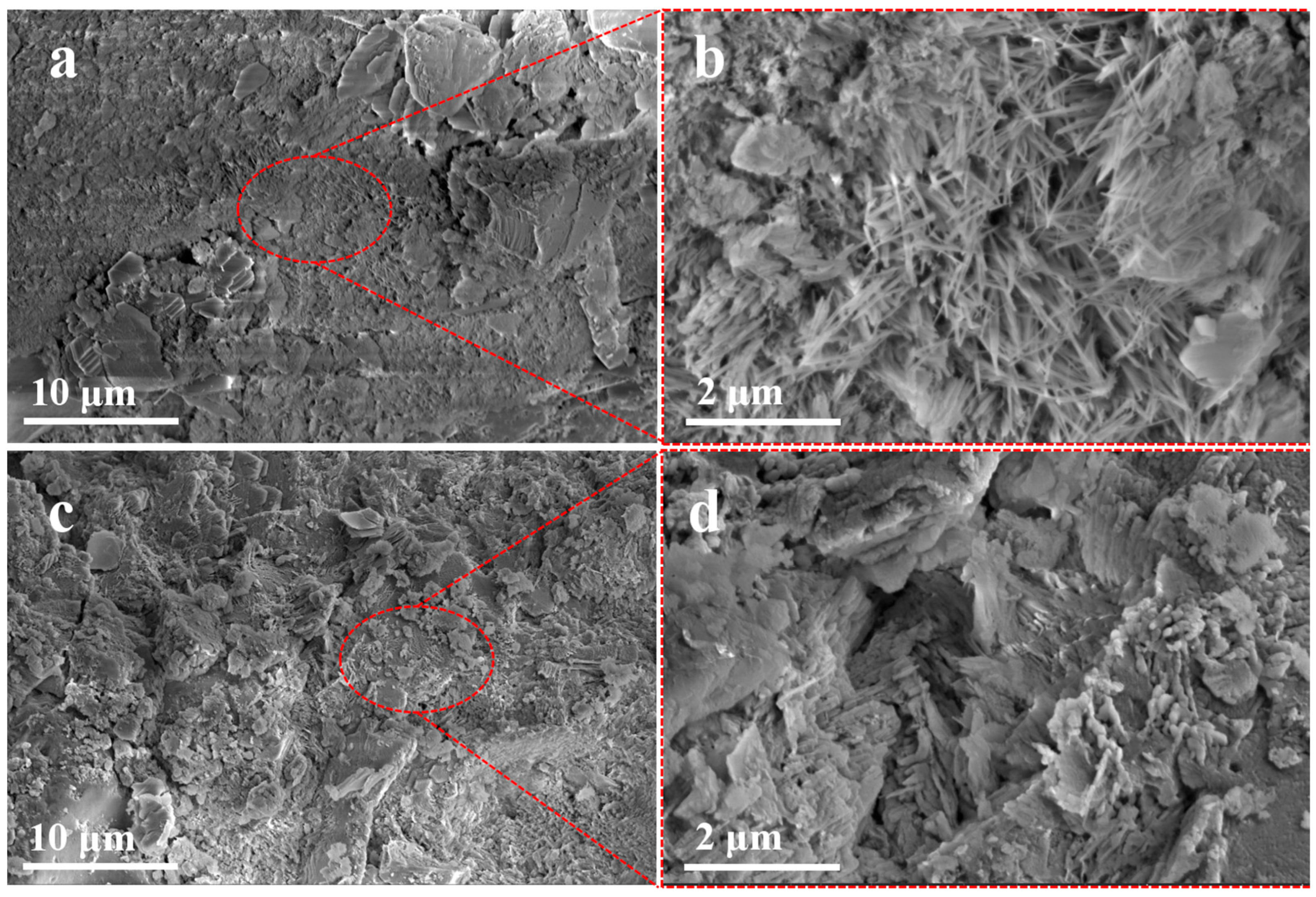
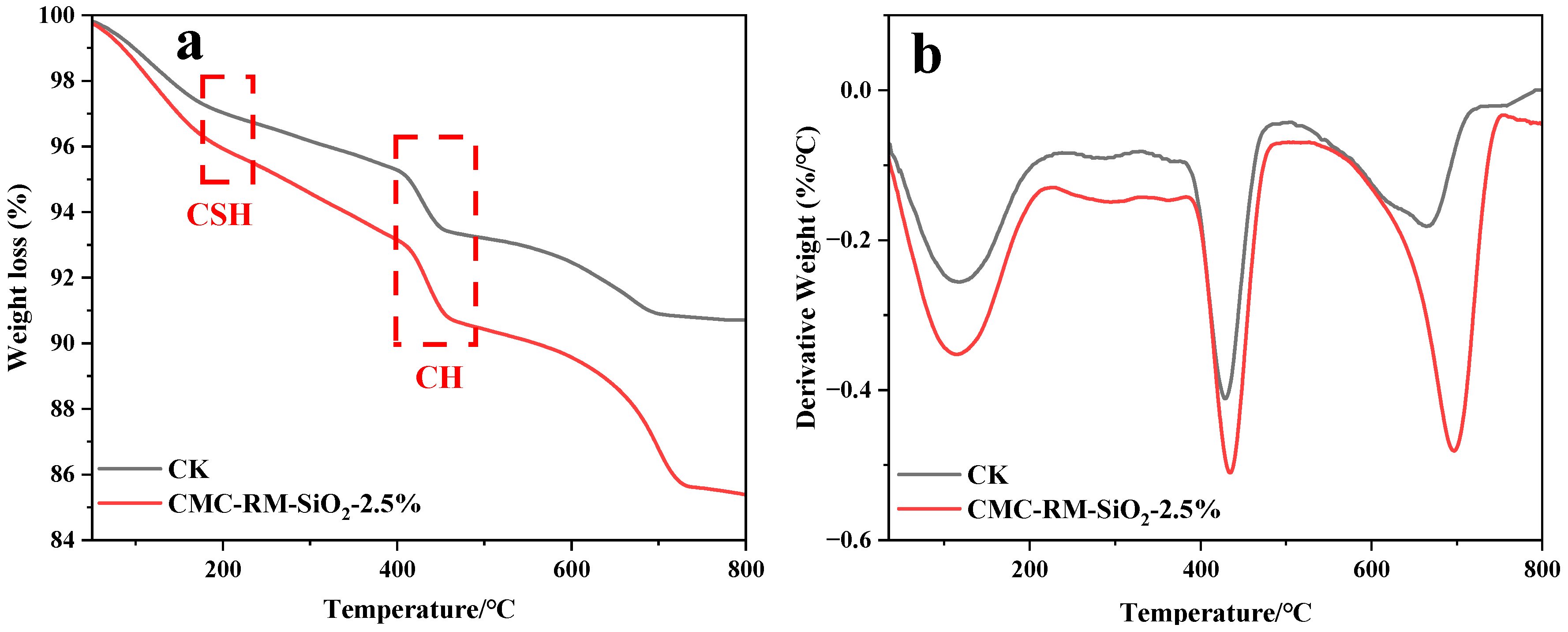

| CaO | SiO2 | Al2O3 | Fe2O3 | MgO | SO3 | K2O | Na2O | TiO2 | |
|---|---|---|---|---|---|---|---|---|---|
| Red Mud | 15.00 | 14.80 | 18.50 | 27.50 | 0.16 | 2.14 | 0.35 | 13.5 | 7.03 |
| Portland Cement | 63.60 | 18.50 | 2.93 | 1.61 | 1.46 | 4.13 | 0.85 | 0.13 | - |
| Samples | Dosage (%) | Symbol | Cement (g) | H2O (mL) | Sand (g) | RM (g) |
|---|---|---|---|---|---|---|
| Reference Cement | - | CK | 450 | 225 | 1350.00 | - |
| CMC-RM-SiO2 | 2.5 | RM-2.5 | 450 | 225 | 1316.25 | 33.75 |
| 5 | RM-5 | 450 | 225 | 1282.50 | 67.50 | |
| 7.5 | RM-7.5 | 450 | 225 | 1248.75 | 101.25 | |
| 10 | RM-10 | 450 | 225 | 1215.00 | 135.00 |
| T/°C | Weight Loss (%) | |
|---|---|---|
| CK | CMC-RM-SiO2-2.5% | |
| 100–200 | 2.973 | 4.061 |
| 400–500 | 2.179 | 2.925 |
| Sample | As | Cd | Co | Cr | Pb |
|---|---|---|---|---|---|
| RM | 0.0964 | 0.0007 | 0.1807 | 0.1047 | 0.0019 |
| CMC-RM-SiO2 | 0.0161 | - | 0.0093 | - | - |
| CK | - | - | 0.0169 | 0.0439 | - |
| CMC-RM-SiO2-10% | 0.0016 | - | 0.0323 | 0.0649 | - |
| GB 8978-1996 [35] | 0.0500 | 0.0050 | 1.0000 | 0.1000 | 0.1000 |
| Sample | BET Surface Area (m2/g) | Pore Volume (cm3/g) |
|---|---|---|
| Reference cement | 11.7026 | 0.001578 |
| CMC-RM-SiO2-2.5% | 14.0190 | 0.001374 |
Disclaimer/Publisher’s Note: The statements, opinions and data contained in all publications are solely those of the individual author(s) and contributor(s) and not of MDPI and/or the editor(s). MDPI and/or the editor(s) disclaim responsibility for any injury to people or property resulting from any ideas, methods, instructions or products referred to in the content. |
© 2025 by the authors. Licensee MDPI, Basel, Switzerland. This article is an open access article distributed under the terms and conditions of the Creative Commons Attribution (CC BY) license (https://creativecommons.org/licenses/by/4.0/).
Share and Cite
Liu, R.; Lin, Z.; Fan, S.; Cheng, Y.; Li, Y.; Li, J.; Zou, H.; Chen, Y.; Zheng, L.; Li, J. Research on the Effect of Calcium Alginate-Red Mud Microspheres on the Performance of Cement Mortar by Partially Replacing Standard Sand. Materials 2025, 18, 3326. https://doi.org/10.3390/ma18143326
Liu R, Lin Z, Fan S, Cheng Y, Li Y, Li J, Zou H, Chen Y, Zheng L, Li J. Research on the Effect of Calcium Alginate-Red Mud Microspheres on the Performance of Cement Mortar by Partially Replacing Standard Sand. Materials. 2025; 18(14):3326. https://doi.org/10.3390/ma18143326
Chicago/Turabian StyleLiu, Ruizhuo, Zibo Lin, Shencheng Fan, Yao Cheng, Yuanyang Li, Jinsheng Li, Haiying Zou, Yongsi Chen, Liting Zheng, and Jing Li. 2025. "Research on the Effect of Calcium Alginate-Red Mud Microspheres on the Performance of Cement Mortar by Partially Replacing Standard Sand" Materials 18, no. 14: 3326. https://doi.org/10.3390/ma18143326
APA StyleLiu, R., Lin, Z., Fan, S., Cheng, Y., Li, Y., Li, J., Zou, H., Chen, Y., Zheng, L., & Li, J. (2025). Research on the Effect of Calcium Alginate-Red Mud Microspheres on the Performance of Cement Mortar by Partially Replacing Standard Sand. Materials, 18(14), 3326. https://doi.org/10.3390/ma18143326






